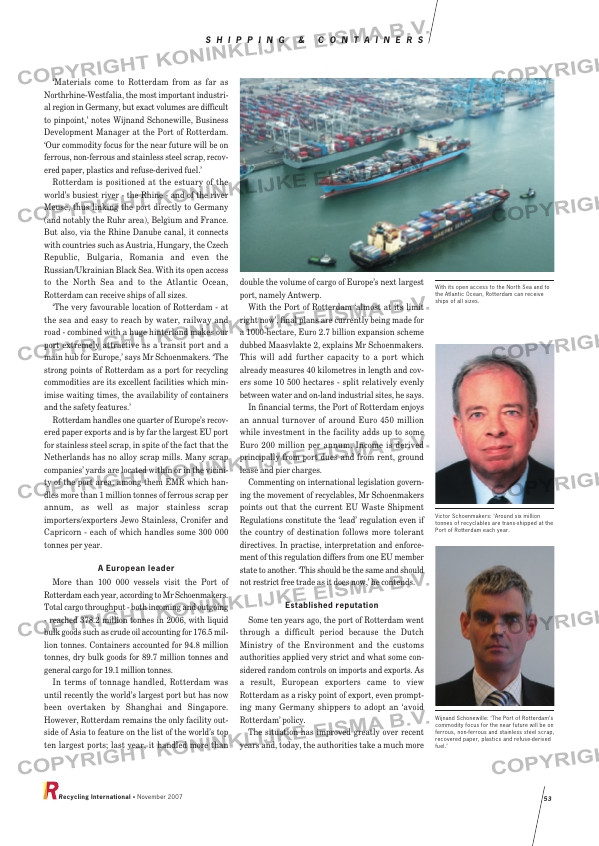Page 53 from: November 2007

‘Materials come to Rotterdam from as far as
Northrhine-Westfalia, the most important industri-
al region in Germany, but exact volumes are difficult
to pinpoint,’ notes Wijnand Schonewille, Business
Development Manager at the Port of Rotterdam.
‘Our commodity focus for the near future will be on
ferrous, non-ferrous and stainless steel scrap, recov-
ered paper, plastics and refuse-derived fuel.’
Rotterdam is positioned at the estuary of the
world’s busiest river – the Rhine – and of the river
Meuse, thus linking the port directly to Germany
(and notably the Ruhr area), Belgium and France.
But also, via the Rhine Danube canal, it connects
with countries such as Austria, Hungary, the Czech
Republic, Bulgaria, Romania and even the
Russian/Ukrainian Black Sea. With its open access
to the North Sea and to the Atlantic Ocean,
Rotterdam can receive ships of all sizes.
‘The very favourable location of Rotterdam – at
the sea and easy to reach by water, railway and
road – combined with a huge hinterland makes our
port extremely attractive as a transit port and a
main hub for Europe,’ says Mr Schoenmakers. ‘The
strong points of Rotterdam as a port for recycling
commodities are its excellent facilities which min-
imise waiting times, the availability of containers
and the safety features.’
Rotterdam handles one quarter of Europe’s recov-
ered paper exports and is by far the largest EU port
for stainless steel scrap, in spite of the fact that the
Netherlands has no alloy scrap mills. Many scrap
companies’ yards are located within or in the vicini-
ty of the port area, among them EMR which han-
dles more than 1 million tonnes of ferrous scrap per
annum, as well as major stainless scrap
importers/exporters Jewo Stainless, Cronifer and
Capricorn – each of which handles some 300 000
tonnes per year.
A European leader
More than 100 000 vessels visit the Port of
Rotterdam each year, according to Mr Schoenmakers.
Total cargo throughput – both incoming and outgoing
– reached 378.2 million tonnes in 2006, with liquid
bulk goods such as crude oil accounting for 176.5 mil-
lion tonnes. Containers accounted for 94.8 million
tonnes, dry bulk goods for 89.7 million tonnes and
general cargo for 19.1 million tonnes.
In terms of tonnage handled, Rotterdam was
until recently the world’s largest port but has now
been overtaken by Shanghai and Singapore.
However, Rotterdam remains the only facility out-
side of Asia to feature on the list of the world’s top
ten largest ports; last year, it handled more than
double the volume of cargo of Europe’s next largest
port, namely Antwerp.
With the Port of Rotterdam ‘almost at its limit
right now’, final plans are currently being made for
a 1000-hectare, Euro 2.7 billion expansion scheme
dubbed Maasvlakte 2, explains Mr Schoenmakers.
This will add further capacity to a port which
already measures 40 kilometres in length and cov-
ers some 10 500 hectares – split relatively evenly
between water and on-land industrial sites, he says.
In financial terms, the Port of Rotterdam enjoys
an annual turnover of around Euro 450 million
while investment in the facility adds up to some
Euro 200 million per annum. Income is derived
principally from port dues and from rent, ground
lease and pier charges.
Commenting on international legislation govern-
ing the movement of recyclables, Mr Schoenmakers
points out that the current EU Waste Shipment
Regulations constitute the ‘lead’ regulation even if
the country of destination follows more tolerant
directives. In practise, interpretation and enforce-
ment of this regulation differs from one EU member
state to another. ‘This should be the same and should
not restrict free trade as it does now,’ he contends.
Established reputation
Some ten years ago, the port of Rotterdam went
through a difficult period because the Dutch
Ministry of the Environment and the customs
authorities applied very strict and what some con-
sidered random controls on imports and exports. As
a result, European exporters came to view
Rotterdam as a risky point of export, even prompt-
ing many Germany shippers to adopt an ‘avoid
Rotterdam’ policy.
The situation has improved greatly over recent
years and, today, the authorities take a much more
S H I P P I N G & C O N T A I N E R S
Recycling International • November 2007 53
Victor Schoenmakers: ‘Around six million
tonnes of recyclables are trans-shipped at the
Port of Rotterdam each year.
Wijnand Schonewille: ‘The Port of Rotterdam’s
commodity focus for the near future will be on
ferrous, non-ferrous and stainless steel scrap,
recovered paper, plastics and refuse-derived
fuel.’
With its open access to the North Sea and to
the Atlantic Ocean, Rotterdam can receive
ships of all sizes.
RI_015 Rotterdam:Opmaak 1 08-11-2007 09:44 Pagina 53



